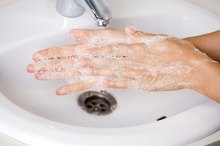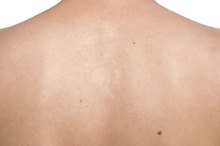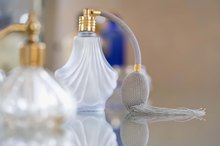Allergic Reaction to Platinum on the Ring Finger
An allergic reaction to your wedding ring, a condition officially known as wedding ring dermatitis, causes the skin underneath to become red, itchy and dry. Wedding ring dermatitis can happen with rings made from various metals, including platinum. While the rash may be a true allergy to platinum, it can also be an allergic reaction to nickel contained in the ring or a skin irritation from trapped residue. A dermatologist can help determine whether you actually have an allergy and to which metal.
Nickel
A common cause of wedding ring dermatitis is nickel allergy 1. Nickel is the most common metal that causes allergies. This silver-colored metal that is sometimes mixed into other metals to make jewelry. Whereas nickel is more common in less expensive rings such as those made from white gold, 10-karat gold or a base metal that has been gold-plated, platinum rings occasionally have nickel as well. If your jeweler is unable to confirm whether your platinum ring has nickel, you can test your ring with a nickel test kit sold by various companies. Allergy to platinum itself, while it does occur, is much rarer than nickel allergy.
- A common cause of wedding ring dermatitis is nickel allergy 1.
- If your jeweler is unable to confirm whether your platinum ring has nickel, you can test your ring with a nickel test kit sold by various companies.
Symptoms and Testing
How to Get Rid of an Allergic Reaction Rash
Learn More
If you are allergic to nickel or platinum, your skin under the ring may be red, itchy, dry, bumpy and look like it has been burnt. In a severe case, your skin may even break out in blisters. While the symptoms usually develop 12 to 48 hours after wearing your ring, you can also develop an allergy suddenly years after wearing your ring. The symptoms, which can last two to four weeks, may also show up in other parts of your body. The exact cause of nickel and platinum allergy is still not known. Your dermatologist can confirm a nickel or platinum allergy by performing a patch test, which involves leaving a small patch with a small amount of the metal on your skin for two days to see if the symptoms develop. You may also use a home nickel allergy detection test.
- If you are allergic to nickel or platinum, your skin under the ring may be red, itchy, dry, bumpy and look like it has been burnt.
- While the symptoms usually develop 12 to 48 hours after wearing your ring, you can also develop an allergy suddenly years after wearing your ring.
Treatment
Unfortunately, there is no cure for nickel or platinum allergy. Once you have developed an allergy, the allergy stays with you for life. Prescription and over-the-counter products such as corticosteroid creams and oral antihistamines can help reduce and improve symptoms. Applying a calming lotion, such as calamine lotion, and wet compresses may also relieve itching and dryness. If the rash on your finger persists beyond four weeks or worsens, see a dermatologist immediately, as this may mean that the skin has become infected. To prevent future rashes, make sure to purchase rings or any other jewelry only from sellers that know how the jewelry is made and are able to confirm that the item does not contain the metal that you are allergic to.
- Unfortunately, there is no cure for nickel or platinum allergy.
- If the rash on your finger persists beyond four weeks or worsens, see a dermatologist immediately, as this may mean that the skin has become infected.
Irritation
Baking Soda & Water for a Skin Rash
Learn More
Instead of an allergic reaction, the rash may actually be irritation from trapped moisture and soap residue. Officially known as irritant contact dermatitis, it occurs when the skin's protective layer is worn away by moisture trapped under the ring. The skin then becomes irritated from soap residue left underneath the ring. If the rash resolves itself after you have washed and thoroughly dried your hands after removing your ring, then it is most likely irritant contact dermatitis rather than an allergy. Removing your ring before washing your hands, showering or doing the dishes and thoroughly drying afterwards will prevent this condition from occurring again. As always, see a medical professional immediately if the symptoms persist or worsen.
- Instead of an allergic reaction, the rash may actually be irritation from trapped moisture and soap residue.
- If the rash resolves itself after you have washed and thoroughly dried your hands after removing your ring, then it is most likely irritant contact dermatitis rather than an allergy.
Related Articles
References
- American Academy of Allergy Asthma & Immunology: Two Cents about Nickel
- Inflammation & Allergy - Drug Targets: Metal Allergens of Growing Significance -- Epidemiology, Immunotoxicology, Strategies for Testing and Prevention
- American Academy of Dermatology: Contact Dermatitis
- Beltrani VS, Bernstein IL, Cohen DE, Fonacier L. Contact Dermatitis: A Practice Parameter. Ann Allergy Asthma Immunol. 2006;97:S1-38.
Writer Bio
Based in the San Francisco Bay Area, Karen Lac has been writing since 1999. Her articles have appeared in “The Occidental Weekly.” Lac also works as a corporate concierge, helping clients with travel and event planning. She holds a Bachelor of Arts in English literature and a Bachelor of Arts in politics, both from Occidental College.









